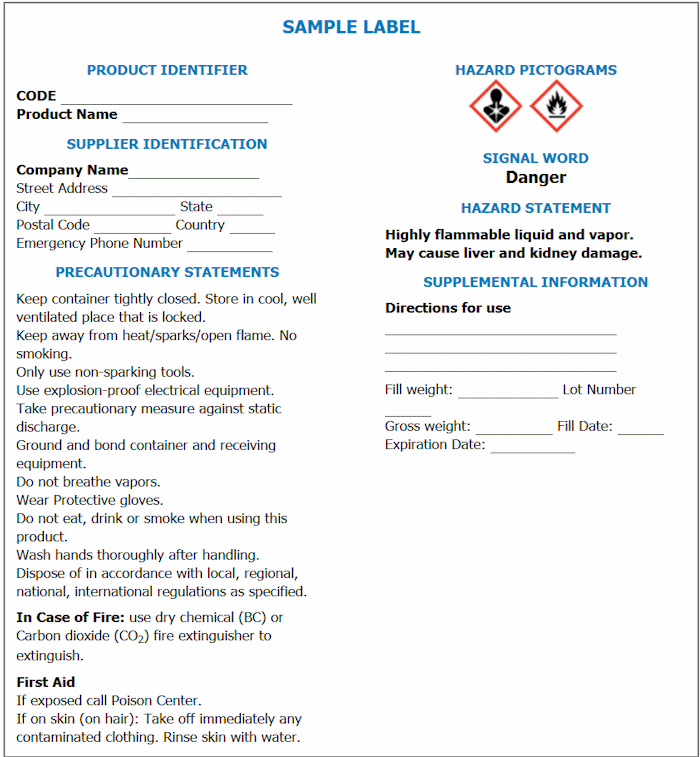Shipped Container Labeling
Under the HCS, labels on containers shipped from manufacturers or distributors, the container must be labeled, tagged, or marked.
Where the chemical manufacturer, importer, or distributor is required to label, tag or mark the following label information must be provided:
- Product identifier that matches the product identifier on the SDS
- Signal word that quickly identifies the level of severity of the chemical
- Hazard statement(s) that describes the nature of the hazards
- Pictogram(s) that conveys specific information
- Precautionary statement(s) that describes recommended measures to minimize or prevent adverse effects
- Name, U.S. address, and U.S. telephone number of the chemical manufacturer, importer, or other responsible party.
- Product Identifier
- The product identifier on the label should match the one used on the Safety Data Sheet (SDS). If the mixture falls under the UN Model Regulations for the Transport of Dangerous Goods, the UN proper shipping name must also be included on the package.
- For substances, the label should include the chemical identity of the substance. For mixtures and alloys, the label should list the chemical identities of any ingredients or alloying elements that contribute to various hazards like acute toxicity, skin corrosion, serious eye damage, germ cell mutagenicity, carcinogenicity, reproductive toxicity, skin or respiratory sensitization, or specific target organ toxicity (STOT).
- Where a substance or mixture is supplied exclusively for workplace use, competent authority may choose to give suppliers discretion to include chemical identities on the SDS, in lieu of including them on labels.
- The competent authority rules for CBI take priority over the rules for product identification and ingredients meeting criteria for CBI do not have to be included on the label.
- Signal Words
- A signal word is used on labels to instantly show the hazard's severity level and alert the reader to a potential hazard. Signal words used in GHS are "Danger" and "Warning." Danger is for the more severe hazard categories. Signal words are assigned to each hazard category
- Hazard Statements
- A phrase assigned to a hazard class and category that describes the nature of the hazards of a hazardous product, including when appropriate, the degree of the hazard.
- Hazard statement and code: Hazard statement codes are intended to be used for reference purposes - they are not part of the text and should not be used to replace it.
- Pictograms
- Pictogram means a graphical composition that may include a symbol plus other elements, such as a border, background pattern or color that conveys specific information.
- Precautionary statements
- Phrase (and/or pictogram) that describes the recommended measures that should be taken to minimize or prevent adverse effects resulting from exposure to a hazardous product. GHS label should include appropriate precautionary information, the choice of which belongs to the labeler or competent authority.
- Precautionary codes are used to uniquely identify precautionary statements and are for reference purposes - they are not part of the precautionary text and should not be used to replace it.
- Supplier identification
- Name, U.S. address, and U.S. telephone number of the chemical manufacturer, importer, or other responsible party.
Transportation
Chemical manufacturers, importers, or distributors must ensure that each container of hazardous chemicals leaving the workplace is labeled, tagged, or marked in accordance with the Hazardous Materials Transportation Act (49 U.S.C. 5101 et seq.) and regulations issued under that Act by the Department of Transportation (49 CFR subtitle B).
The label for bulk shipments of hazardous chemicals must be on the immediate container, transmitted with the shipping papers or the bills of lading, or, with the agreement of the receiving entity, transmitted by technological or electronic means so that it is immediately available to workers in printed form on the receiving end of shipment.
Where a pictogram appears on a shipped container, the pictogram for the same hazard is not required on the label.
Knowledge Check Choose the best answer for the question.
3-2. Which GHS term is used to quickly indicate the level of severity associated with a material?
You forgot to answer the question!

